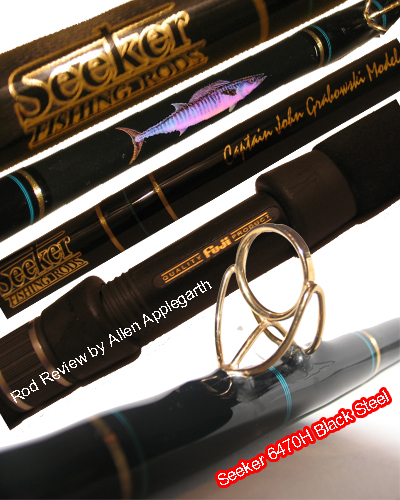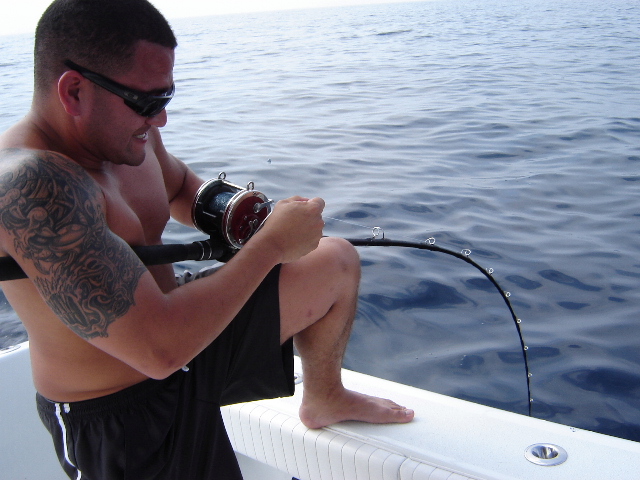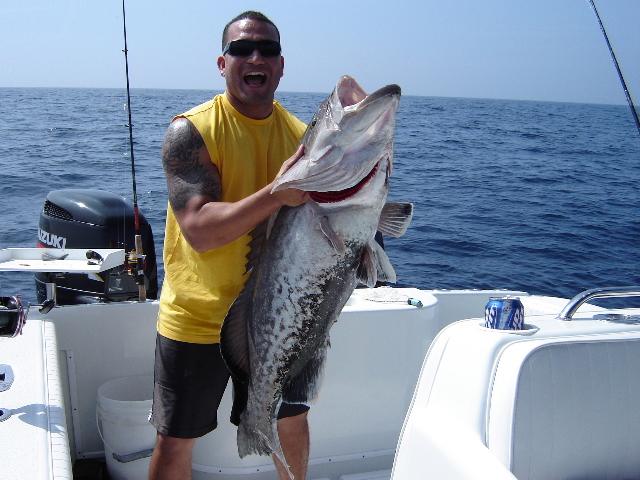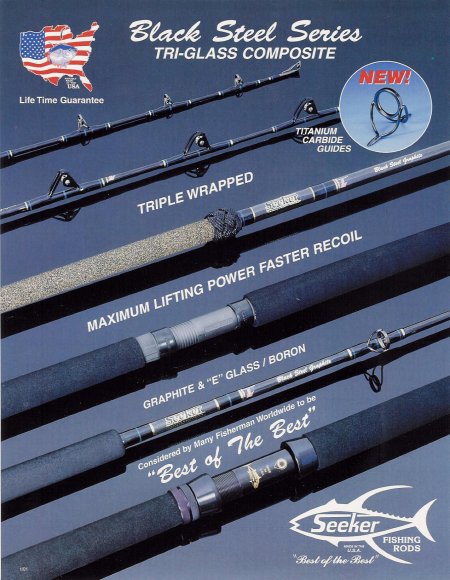|
|||
|
Seeker Review by: Allen Applegarth Model in this Review: Seeker 6470H Black Steel
Photos of my actual rod
Seeker rods are manufactured in the USA out of Long Beach California. Joe Pfister, President of Seeker ensures that they remain a leader in the industry by implementing new technology and resin blends along with top grade materials into their rod designs. With hundreds of models and thousands of blanks to choose from, it's almost like they designed a rod for every angler.
Most modern rods are made of fiberglass, graphite, or a combination of the two. Both make good rods and each have their own qualities that make them different in key aspects. Graphite rods usually cost more than a fiberglass rod of the same quality, but a good fiberglass rod will be a lot more expensive than a cheap graphite rod. Graphite rods are lighter than glass, have less flex but are much easier to break. They are more sensitive and offer better feel for finesse fishing. New technology however has rod makers such as Seeker combining the two. These hybrid rods are usually based on graphite with either “E” or “S” type glass and a proprietary blend of boron fiber to create a very strong, durable and light rod that has the best of both worlds. A big part of the rod quality is in the actual building process of the rod. Seeker, for example, reverses the direction of composites to create additional strength through a counter action theory, which works very well. The new composite rods offer much more reliability in the big fish category than any single blend can, but single blend rods still have their place in the industry. Client fishing a Seeker 6470 The Result Speaks Volumes!
Seekers Black Steel series comes in a wide variety of flavors to fit everyone, anywhere and for any species. “The Black Steel series 6470 is a rod that I will always enthusiastically recommend to anyone looking for a serious offshore rod.”
Rod Features Rod action is used to describe the flex point of a rod, NOT its power. Generally, a Fast action rod will flex in the upper 1/3 of the blank, a Medium action will flex in the upper ½ of its length and a slow action will flex throughout the rod. Power usually refers to the rod stiffness and resistance to bending, which is shown on the side of the rod in the form of numbers such as 40 (50) 60. Use the middle number. Be warned that cheap rods do not hold true to the numbers, so if you’re not in the mid to high end rods you’ll have to judge for yourself through common sense. Guides are another area of great importance. There are 3 main guide manufactures, Fuji, Pac Bay and American Tackle. If you want a long lasting rod look for these guides. Guide spacing and amount are also important. As a rule of thumb, 8- 9 guides and a tip on a 7 foot heavy rod is excellent, whereas 6 guides and a tip on a spinning rod is also excellent. If it looks like it’s a few eyes shy then it probably should stay on the rack. Grips are important and often hard to distinguish the bad from the good. Generally, look for tight pores in the material and ensure it still retains a softness. Good quality material such as Seekers hypalon or cork enhanced EVA are tight-pored but retain a good soft feel. Contact Us All rights reserved. For permission to use this article contact: Author: Allen Applegarth |
There was a time when many anglers picked their big game or sport fishing rods based on the broom stick model—short, stiff and strong! Surely a short thick rod would hoist in that trophy fish one might think, but many stories abound and lessons learned of broken lines, rods and aching backs. Today, however, I think many anglers have become more rod savvy and look for that ergonomically engineered masterpiece that won’t break their back, the bank or their line. Besides looking great, which by the way is a crucial element in today’s rod choices; modern rods are incorporating new technology that may baffle even the best of anglers. With so many choices and new or reinvented materials and building methods, where does one turn to find the right rod? The only true way to find the rod that is a good fit for you is to fish with as many as you can get your hands on, or read testimonials like this. For me, that search stopped abruptly when I wrapped my hands around a black steel seeker 6470h with a 30 pound gag looking to bring me down to his level. When fishing the west coast of Florida during the summer you tend to motor a long way due to shallow water and the movement of the larger fish to deeper water. Because of long rides you want equipment that is going to perform time after time and not put your body through too much stress. There’s something special about catching grouper for us on the west coast of Florida, and we take it very seriously. The thrill of picking a fight with this clever heavyweight on his own turf gets the blood pumping and nothing is worse than losing one to the rocks because your rod failed, didn’t have enough backbone or the subtle nuances required to let you know it’s time to get down and dirty. It’s a man versus beast feeling when you hook that wrecking ball below, so having the right rod is invaluable. On a recent trip last summer we planned a 50 mile run in search of larger grouper and red snapper. The day before the trip I discussed our plans and the gear needed for the trip. I had just purchased an 8ft Diawa that spring and turned a few big fish with it, but felt the rod to be a little faster then I like for bottom fishing for big gags. I turned to my rod holder and without my partners knowledge swapped out his rod for mine and dropped a bait overboard. Before he even noticed that I snatched his gear I was able to put the rod to the test, as it flexed its muscle before my bait even hit the bottom. My first impression of the seeker 6470H Black Steel was a medium fast action rod that quickly stiffens up and is designed for turning that large fish in the right direction, as it performed beyond expectations on the first 15 pound gag of the day. My next drop gave me a chance to get a bit more acquainted with the rod. I could feel the bait getting nervous 150 feet below, evident by a series of slight twitches and abnormal reactions. It didn’t take long for a large gag grouper to find the bait. When he took the bait I muscled up and turned up the heat, knowing that I had to keep the fish from making that dreaded dive to the rocks. This is where the rod showed its true colors. Every time the fish made a hard run the rod stiffened up and put on the brakes. It was just a matter of me having the ability to crank without the reel locking up to avoid pumping the rod. This rod simply impressed me through every movement of that catch. It was love at first bite! I find it quite amazing to have that much feel and touch in a rod so stout and still be able to turn a 30 pound gag on a dime. You can feel the graphite going to work in this rod for sure. The rest of the day I turned fish after fish away from the rocks and wrecks making for one memorable trip and one future customer for seeker. I have fished with many 40-60 pound class rods and have not been fully confident in the numbers printed on the side of the rods, but with the Seeker 6470H Black Steel I have no doubt that it is underrated @ 40-60lbs. Seeker builds some of the most appealing rods to ever hit the market. They are all high performance rods built using Seeker's proprietary blend of material and technology, and detail to craftsmanship. The technology behind the Black Steel series was well thought out and implemented into a successful and beautiful rod design. Because some may not know the finer details between graphite and glass rods, let’s take a brief second and touch on a few points. 1) Graphite rods have less flex than pure fiberglass rods, and for this they are generally not considered for heavy deep water action. 2) Graphite rods have more feel, action and finesse than fiberglass rods. 3) When graphite rods reach their maximum flex point the graphite fibers fold over and snap the rod fairly easily. 4) Graphite rods are lighter and generally stiffer than fiberglass. Enter Seeker: Seeker sought to integrate the benefits of both materials, making for a light, strong and flexible rod with characteristics of glass and graphite; suitably named Black Steel. Seeker’s technique entails laying the E-Glass in one direction while the graphite is laid in another, producing a counter action that prevents the rod fibers from buckling over. The 6470H Black Steel is a tri glass composite constructed with graphite 120, carbon fiber, e glass/boron and weighs just 24 ounces. The light weight of this stout rod provides just the right sensitivity to feel even the smallest baits in distress, giving you an early indication of a coming strike. The sensitivity of this rod has a close distinction of pure graphite, and surprisingly I could easily distinguish the sand from the rock bottom in 150 feet; not something that is easy to do in a multi-composite rod. The graphite portion runs about 2/3rds up the rod from the butt and intertwines with the E glass/boron blend that extends the entire length of the rod. In essence, this lends to the rods medium-fast action from the tip to 1/3rd back, and then the backbone really kicks in throughout the graphite and E glass blend. The guides are stainless steel coated in titanium and are incredibly strong, corrosion resistant and easily bear the stress of big fish. For your comfort these rods come equipped with very soft hypalon grips, another innovative incorporation by Seeker. The hypalon material is very easy to rinse clean, does not trap or hold debris like conventional foam, and as for fish scales and slim—well they just seem to come off with no hassle. The fore grip on this rod also provides ample room for leveraging that big fish to submission. It is a west coast rod design, but for Florida anglers it makes for a perfect big grouper stick. One thing that I really like about this rod is that I am able to pump and high stick without the risk of overloading the rod. Personally, I’m one of those anglers that is determined to get the fish off the bottom quickly by high-sticking with a brief hold until I feel it’s safe to start cranking down. This rod stiffens quickly after tension is applied and the fast recoil seems to give me that edge right at the peak of my hold and really favors turning the fish upward. It flexes at all the right points and doesn’t feel stressed or sloppy even under the immense pressure of a 30 pound gag pulling from 150 feet below. The Black Steel composite mix delivers the goods when it comes to sheer muscle and snapping this rod is of no concern, as you’re most likely to fold before the rod does. New for 2010 will be the incorporation of solid titanium guides found on the super seeker series. Also, Joe Pfister, President of Seeker Rods recently told me that Seeker will be making a presence in Florida. In fact, I have been speaking with Joe about the possibilities of designing a grouper rod for the west coast of Florida, and there is a good chance that we may just see that in the very near future. I know there are many anglers crossing their fingers. I think I speak for many of us, especially those lucky enough to have wet a line with this rod, when I say welcome to Florida Seeker. Pros: You get a great rod with more back bone than you'll probably ever need, and it's light and well balanced. -It's nothing short of beautiful and well crafted with high-end material. -You'll have compete confidence in the rod and not worry about blowing it up. -You're friends will envy you! Cons: -A bite more pricey, but you get what you pay for. -Some concerns about guides corroding. -About the same cost as a custom rod. UPDATE: 2011 -After 3 years of light use I am seeing some unwanted corrosion on the 2 piece guides on both of my Black Steel 6470H rods. The corrosion is setting in on the welds and various parts of the metal. After speaking with Seeker and getting a few options as answers, they either are of a bad batch or a result of higher salinity levels in our Florida water vs California, which I am leaning towards. The image below shows this rod getting close to losing the tip as the other did in the next image.  
These rods are used roughly 6 times per year and stored in climate control with all of my other gear. I have other rods without a hint of corrosion on year 4, and then some other brands that barely made 2 years. I clean my guides pretty well between use, and use a soft brush on the guides to ensure any salt particles are removed. After further checking both 6470's I can forsee an immediate rebuild in order, as the majority of guides are green on at the welds. I'll retire the one Black Steel for now and report back later. UPDATE: 2012 - June Went to pack the rods on the boat and found a missing guide on the last of my usable Black Steel rods. After looking closer at the guides I can see the green monster devouring the guides slowly, so both are taking early retirment after 4 years of light use. I'll get them redone in the future, as the rods themselves are excellent.  
Conclusion: The Black Steel 6470H is an excellent rod that handles very well. The rod finish is is top notch, but the welded 2 piece guides are a bummer and disappointing as a Florida angler. That is the only negative I see on these rods. It doesn't even appear to be the base material, as the weld material is failing, and I suspect it's from the heat of the weld. If Seeker put better guides on this rod I could really stand behing the purchase price, but for the price, go custom with quailty one piece titanium or ss guides. Fight the fish, not the rod! Allen Applegarth |
||
|
|
|||




